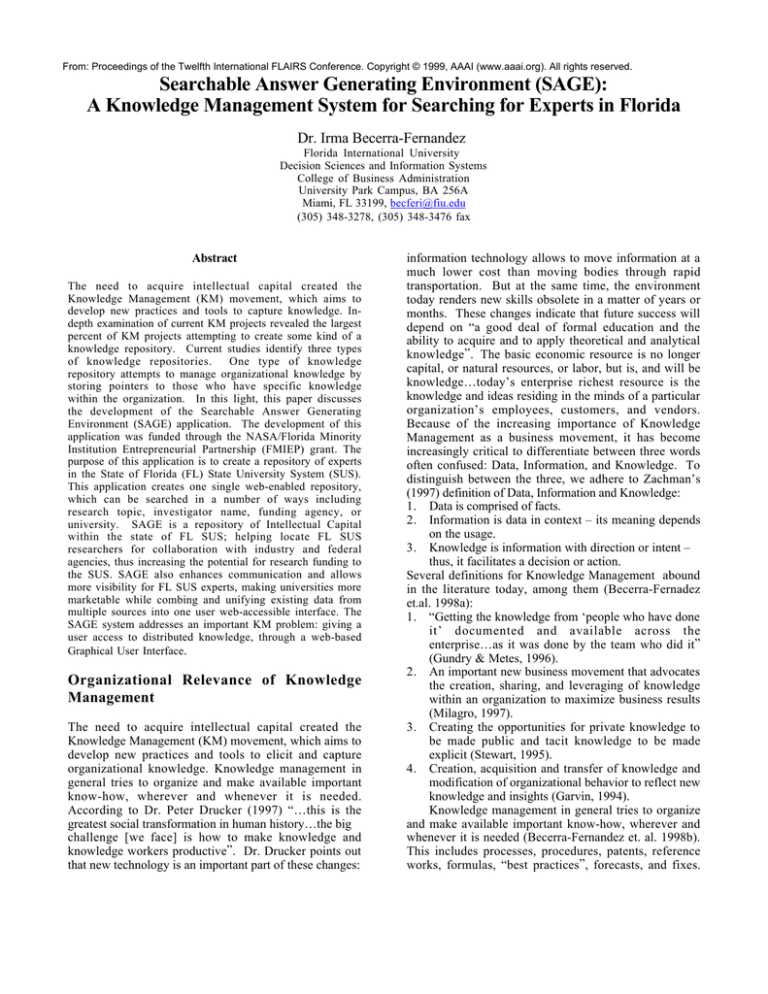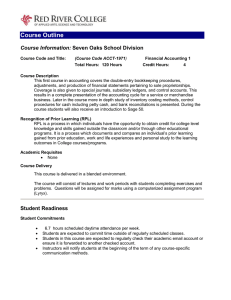
From: Proceedings of the Twelfth International FLAIRS Conference. Copyright © 1999, AAAI (www.aaai.org). All rights reserved.
Searchable Answer Generating Environment (SAGE):
A Knowledge Management System for Searching for Experts in Florida
Dr. Irma Becerra-Fernandez
Florida International University
Decision Sciences and Information Systems
College of Business Administration
University Park Campus, BA 256A
Miami, FL 33199, becferi@fiu.edu
(305) 348-3278, (305) 348-3476 fax
Abstract
The need to acquire intellectual capital created the
Knowledge Management (KM) movement, which aims to
develop new practices and tools to capture knowledge. Indepth examination of current KM projects revealed the largest
percent of KM projects attempting to create some kind of a
knowledge repository. Current studies identify three types
of knowledge repositories.
One type of knowledge
repository attempts to manage organizational knowledge by
storing pointers to those who have specific knowledge
within the organization. In this light, this paper discusses
the development of the Searchable Answer Generating
Environment (SAGE) application. The development of this
application was funded through the NASA/Florida Minority
Institution Entrepreneurial Partnership (FMIEP) grant. The
purpose of this application is to create a repository of experts
in the State of Florida (FL) State University System (SUS).
This application creates one single web-enabled repository,
which can be searched in a number of ways including
research topic, investigator name, funding agency, or
university. SAGE is a repository of Intellectual Capital
within the state of FL SUS; helping locate FL SUS
researchers for collaboration with industry and federal
agencies, thus increasing the potential for research funding to
the SUS. SAGE also enhances communication and allows
more visibility for FL SUS experts, making universities more
marketable while combing and unifying existing data from
multiple sources into one user web-accessible interface. The
SAGE system addresses an important KM problem: giving a
user access to distributed knowledge, through a web-based
Graphical User Interface.
Organizational Relevance of Knowledge
Management
The need to acquire intellectual capital created the
Knowledge Management (KM) movement, which aims to
develop new practices and tools to elicit and capture
organizational knowledge. Knowledge management in
general tries to organize and make available important
know-how, wherever and whenever it is needed.
According to Dr. Peter Drucker (1997) ÒÉthis is the
greatest social transformation in human historyÉthe big
challenge [we face] is how to make knowledge and
knowledge workers productiveÓ. Dr. Drucker points out
that new technology is an important part of these changes:
information technology allows to move information at a
much lower cost than moving bodies through rapid
transportation. But at the same time, the environment
today renders new skills obsolete in a matter of years or
months. These changes indicate that future success will
depend on Òa good deal of formal education and the
ability to acquire and to apply theoretical and analytical
knowledgeÓ. The basic economic resource is no longer
capital, or natural resources, or labor, but is, and will be
knowledgeÉtodayÕs enterprise richest resource is the
knowledge and ideas residing in the minds of a particular
organizationÕs employees, customers, and vendors.
Because of the increasing importance of Knowledge
Management as a business movement, it has become
increasingly critical to differentiate between three words
often confused: Data, Information, and Knowledge. To
distinguish between the three, we adhere to ZachmanÕs
(1997) definition of Data, Information and Knowledge:
1. Data is comprised of facts.
2. Information is data in context Ð its meaning depends
on the usage.
3. Knowledge is information with direction or intent Ð
thus, it facilitates a decision or action.
Several definitions for Knowledge Management abound
in the literature today, among them (Becerra-Fernadez
et.al. 1998a):
1. ÒGetting the knowledge from Ôpeople who have done
itÕ documented and available across the
enterpriseÉas it was done by the team who did itÓ
(Gundry & Metes, 1996).
2. An important new business movement that advocates
the creation, sharing, and leveraging of knowledge
within an organization to maximize business results
(Milagro, 1997).
3. Creating the opportunities for private knowledge to
be made public and tacit knowledge to be made
explicit (Stewart, 1995).
4. Creation, acquisition and transfer of knowledge and
modification of organizational behavior to reflect new
knowledge and insights (Garvin, 1994).
Knowledge management in general tries to organize
and make available important know-how, wherever and
whenever it is needed (Becerra-Fernandez et. al. 1998b).
This includes processes, procedures, patents, reference
works, formulas, Òbest practicesÓ, forecasts, and fixes.
From: Proceedings of the Twelfth International FLAIRS Conference. Copyright © 1999, AAAI (www.aaai.org). All rights reserved.
Technologically, Intranets, GroupWare, data warehouses,
networks, bulletin boards, and video-conferencing are key
tools for storing and distributing this intelligence
(Maglitta, 1996).
It has been observed that KM systems underway at
most organizations fall into three categories (Davenport et.
al., 1997a):
1. Projects that created a knowledge repository, and
whose objective was to take some form of knowledge
and store it in a technical system for later access;
2. Projects which attempted to manage knowledge
assets from a financial perspective (Becerra-Fernandez,
1997); and
3. Projects that attempted to improve the knowledge
environment: either through the appreciation for
knowledge, or by promoting knowledge sharing.
An in-depth examination of the first kind of KM
systems and projects that created a knowledge repository,
revealed three types of knowledge repositories (Davenport
et. al., 1997a):
a. In the first type of knowledge repository,
organizational knowledge existed in some kind of
explicit form, typically highly structured documents,
for example systems to store marketing-oriented
documents.
b. The second type of knowledge repository consisted of
developing less structured databases of employeesÕ
insights and observations. These projects are
typically called Òdiscussion databasesÓ or Òlessonslearned systemsÓ.
c. Finally, the third type of knowledge repository
attempts to manage organizational knowledge by
storing pointers of those who have specific knowledge
within the organization. For example, Microsoft uses
this type of project to store software-systems
development knowledge.
In the next sections, we look at the third type of
Knowledge Management Systems in detail. The need for
experts is not new but Òthe demand for specialized
knowledge
and
experience
is
on
the
increaseÉrestructuring and downsizing drive much of the
increase, and the evolving challenges often call for
management consultants across departmentsÉtechnical
areas demand new information and expertiseÓ (Wheaton,
1997). To know who and where experts are is one of the
most challenging activities that organizations face.
Furthermore, Òlocating experts, specialists, and expert
witnesses can take you all over the database and Internet
mapÓ (Schumacher & Dolan, 1995). Nowadays, when
the Internet represents the biggest source of information, it
is natural to suppose that it can be a good place for
searching for experts. Currently, it is possible to go over
the Internet and search for experts, but the search
techniques and the existent databases are more useful if the
searcher knows the name of the person he/she is looking
for. Most of the time, this is not the case and what the
researcher has is a group of parameters or requirements
that need to be fulfilled. Furthermore, the most important
element in seeking for qualified experts is precisely that:
ÒqualifyingÓ the expert. Recognized indicators of
expertise might include for example finding the most
prolific writers, but being a prolific writer does not
necessarily guarantee expertise, since authors may spend
so much time writing that they donÕt spend much time
ÒdoingÓ.
The Microsoft SpuD Project
Employees at the Microsoft Corporation need a high level
of knowledge and competency due to the quick and
evolving nature of their field. Therefore, Microsoft pays
special attention to the hiring and promotion process in
order to employ the most capable individuals. For this
purpose, a pilot application was created for the
Information Technology (IT) group within Microsoft.
This project was named ÒSkills Planning und (and)
developmentÓ, known as ÒSpuDÓ. The goal of this
project was to develop a database containing job profiles
available online. These profiles compile the knowledge
and competency of each employee in the IT group. It is
anticipated that this project will help match employee
competency with jobs and work teams. The goals of this
project are to develop a database containing job profiles
available online, and to help match employee competency
with jobs and work teams. The following are the five
major components of the SPUD project (Davenport,
1997b):
1. Development of a structure of competency types and
levels;
2. Defining the competencies required for particular jobs;
3. Rating the performance of individual employees in
particular jobs based on their competencies;
4. Implementing the knowledge competencies in an
online system;
5. Linkage of the competency models to learning
offerings.
The objective of the employee categorizing process
was to assemble a competency catalogue that could be
used all across Microsoft. This way, a company employer
seeking new personnel can search for an employee having
the qualifications required for the position. As an
example, Davenport (1997) suggests that the employer
query the on-line system and ask, ÒGive me the top five
candidates who have leadership skill levels on 80% of the
competencies for this job and who are based in
MicrosoftÕs headquarters located in WashingtonÓ. Using
Microsoft Access, a prototype of the system was created
based on a Structured Query Language (SQL) server as the
database for MS Access, as well as a Web front end.
Using a Web front end allowed for the publication of data
around the world using the Internet and a web browser.
To this day, the pilot project has had positive. In
conclusion, the end results of a project like SpuD depend,
to a large extent, on the acceptance of the individuals who
are going use it. Furthermore, it will be important that
employees and supervisors feel they have contributed to
From: Proceedings of the Twelfth International FLAIRS Conference. Copyright © 1999, AAAI (www.aaai.org). All rights reserved.
the development of templates for the jobs, since it will be
easier for them to adopt the Competency Model. Note
that the validation of the data in this model rests with the
manager, who essentially assigns the competency criteria
to each of the employees under his/her supervision.
UWF Extraction
Algorithm
FAMU Extraction
Algorithm
SAGE
Middleware
Client
UNF Extraction
Algorithm
UWF
FAMU
UNF
FSU
FSU Extraction
Algorithm
UF
The Searchable Answer
Environment (SAGE)
Generated
SAGE
DATABASE
USF
FGCU
In the same context of the Microsoft ÒSpuDÓ project, the
NASA/Florida Minority Institution Entrepreneurial
Partnership (FMIEP) grant is funding the development of
the ÒSearchable Generated Environment (SAGE)
Knowledge Management System. The purpose of this
KM System is to create a repository of experts in the
State of Florida (FL) State University System (SUS).
Previous studies have pointed out that there is a void in
the ability to identify the capabilities in the SUS
(Kotnour, 1998). Currently, each State University in
Florida keeps a database of funded research, but these
databases are disparate and dissimilar. The SAGE KM
System creates one single repository by incorporating a
quasi distributed database scheme, which can be searched
by a variety of fields, including research topic,
investigator name, funding agency or university. As
NASA-KSC looks to develop new technologies necessary
for the continuation of their space exploration missions,
their need to partner with Florida SUS experts becomes
evident.
The SAGE system combines the unified database
by masking multiple databases as if they were one. One
advantage of this method is that there is no need to
reconfigure the data to fit it into one template. This
methodology provides flexibility to the users and the
database administrator, regardless of the type of program
used to collect the information at the source (e.g. Dbase,
FoxPro, Informix, Oracle, Sybase, MySQL, etc.). On the
other hand if desired to conform the data under one
system, it can be implemented as well. Although the
project SAGE is specific in nature, what was desired was
to develop tools and techniques that would make
managing databases as seamlessly as possible.
The SAGE KM System combines and unifies
existing data from multiple sources into one user
accessible interface. Ideally the aggregated data would be
accessible from one point of entry. For example, the data
being accessed may consist of multiple data types that
have been converted to a standard file format. SAGE
consists of the typical university sponsored research data.
One of SAGE's advantages is that there is only one point
of entry or a web enabled interface, allowing multiple
occurrences of the interface and giving the end user
deployment flexibility. The main interfaces on the query
engine use text fields to search the processed data for key
words, fields of expertise, names, or other applicable
search fields. The application processes the end user's
query and returns the pertinent information (see Figure 1).
SAGE
Web Server
UF Extraction
Algorithm
UCF
UCF Extraction
Algorithm
FAU
FIU
USF Extraction
Algorithm
FAU Extraction
Algorithm
FIU Extraction
Algorithm
FGCU Extraction
Algorithm
State University System
Sponsored Research
Standard Query Language (SQL)
Compatible Databases
SAGE Interface (Web Browser)
SAGE Application
Figure 1: SAGE Architecture
The purpose of the SAGE KM System is to
unify myriad data collections into one database collection
that could easily be mined for relevant data. SAGE will
give university researchers more visibility, and at the
same time will allow interested parties to identify
available expertise within the SUS. This application
helps to identify a researcher's expertise within a
discipline, and to facilitate communication or a point of
contact. The benefits of SAGE are: (1) SAGE is a
repository of Intellectual Capital within the state of FL
SUS; (2) SAGE helps locate FL SUS researchers for
collaboration with industry and federal agencies, thus
increasing the potential for research funding to the SUS;
(3) SAGE enhances communication and allow more
visibility for FL SUS experts, making universities more
marketable; and (4) SAGE combines and unifies existing
data from multiple sources into one user web-accessible
interface. The SAGE system addresses an important KM
problem: giving a user access to distributed knowledge,
through a web-based Graphical User Interface.
SAGEÕs strength also rests in its ability to
search for experts by using a set of parameters instead of a
proper name (even though this is a possibility also) and
in the fact that it validates the data at the source, using the
assumption that researchers who successfully obtain
funded research grants are indeed experts in their fields.
Other related current work is the development of "ProfNet,
a database that lists public information officers for major
universities, nonprofit organizations, and certain
government facilities" (Ojala, 1995). A difference between
SAGE and ProfNet is that the latter is not searchable by
any individual over the Internet. Ojala explains that in
Profnet public information officers who belong to the
network query names of experts in a specific field. Then,
the officers check in their institutions for the required
expertise and return answers electronically. Thus, this is
batch rather than interactive searching (1995). Another
difference between SAGE and ProfNet is that SAGE is a
more user friendly search engine that will give the user
results immediately, instead of waiting for a response.
From: Proceedings of the Twelfth International FLAIRS Conference. Copyright © 1999, AAAI (www.aaai.org). All rights reserved.
Another advantage that SAGE provides is that itÕs built
upon a searching criteria that is recognized as a valid
indicator of expertise, such as grants received and
institution of employment. In most of the possibilities
available on the Internet, the entity seeking for an expert
has to use a combination of different tools in order to get
this information. In short, SAGE is an interorganizational system that provides users with the ability
to locate experts.
The Technologies to Implement SAGE
SAGE is built upon the integration of the following
technologies (see Figure 2):
1. Cold FusionTMÐ An off-the-shelf Rapid and
Integrated Development Environment.
2. Open Database Connectivity (ODBC) allows
middle-ware to interface with the database.
3. Verity's Search 97- enables document indexing,
classification, search and retrieval personalized
information dissemination. Search 97 allows the
end-user to run sophisticated boolean searches,
utilizing proximity operators, and relational
operators. Verity 97 facilitates dynamic meta-data
generation, along with incorporated relevance ranking
in queries. Verity is used to perform the Keyword
search, within the field that contains the grant
abstract. In this way, you can use the Keyword
ÒKMÓ to identify experts currently working in
Knowledge Management, since the abstract that
defines the project is expected to contain the word
ÒKnowledge ManagementÓ as part of the research
abstract.
The development of the SAGE database involved an
initial design followed by incremental implementation
phases. The initial design phase constituted a
comprehensive survey of available tools and
methodologies. An assessment was carried out to select
the most efficient approach to data storage and data
retrieval. The two methodologies considered for data
access were Common Gateway Interface (CGI), and
Middle-ware. Cold FusionTM was chosen as the Middleware development environment because of its significant
application strength and its demonstrated database
interaction capabilities. Additionally, it provided the
ability for secure transactions with Secure Socket Layer
(SSL) technology, with the potential for strong
encryption.
The implementation phase of SAGE involved the
design of Cold Fusion modules, each with an assigned
task. A robust server environment was set up along with
a server operating system with remote user capabilities.
Querying modules were used to provide search
capabilities. Each query interface involved several
modules that interacted with the database. Relational
Databases were chosen because of their efficiency and
flexibility with data. A sample database was obtained
from the Florida International University Division of
Sponsored Research and Training (DSRT) to provide a
prototype data storage structure in a relational database.
After applying an extraction algorithm to the data, the
SAGE database was populated with FIU data.
The next step was alpha testing the interface both
locally and remotely. The evaluation phase of SAGE will
include heavy end user testing and processing time
optimization. The SAGE application was then webenabled on the primary server for its current wave of beta
testing.
Figure 2: The technologies to implement SAGE
Some of the technical challenges faced during the
design and implementation of this project included the
fact that databases from FL SUS DSRT offices were
dissimilar in design and file format, and also in duplicate
data occurrences, field names, and stored architecture. To
resolve these problems PERL scripts were used to solve
the database disparities, and a Data Dictionary was
implemented to eliminate redundancies. One of the most
important research contributions of SAGE is the merging
of inter-organizational Database Systems through the use
of correspondence tables, which function much like array
pointers, and allow compliance to differing database
formats. Through the correspondence tables we resolve
finding similarities between database fields, no matter
how different their original formats are.
The Future of SAGE
SAGE is a KM System in enterprise information
management that is quite adaptable to the corporate
environment. If used in corporate organization
environments, SAGE can provide an organization with
timely, pertinent, and cost effective data about internal
strengths and capabilities, with a mature information base.
This ability to catalog corporate and organizational assets
is of prime concern to large organizations. Organizations
have long desired to harness internal expertise, instead of
relaying on consultants or third party contractors.
Corporate prototype deployment would ideally involve
From: Proceedings of the Twelfth International FLAIRS Conference. Copyright © 1999, AAAI (www.aaai.org). All rights reserved.
one group, preferably a unit that has Lightweight
Directory Access Prototype (LDAP) directory enabled
information network systems. This would drastically
improve development time and overall usability and
functionality. The directory "enabled" network will allow
SAGE to keep a current listing for end user access,
providing real-time responses to queries.
Acknowledgments
The Author wishes to acknowledge NASA-KSC and
Bethune-Cookman College, for financial support to this
project, entitled ÒFlorida Minority Institution
Entrepreneurial Partnership GrantÓ, grant number NAGO0220. Also the author wishes to acknowledge the
contributions of the students who work in the FIU
Knowledge Manangement Lab, particularly Marta March,
Aracelys Rodriguez, Raheem Seecharan, Riyaad
Seecharan, and Levi Stanley.
References
I. Becerra-Fernandez (1997). ÒMethodology to Harvest
Intellectual Capital at KSCÓ. KSC Research &
Technology 1997 Annual Report.
Becerra-Fernandez, I., Riedel, J., & Lee, T. (1998a,
February). Knowledge Management: Redefining
Corporate Assets. Proceedings of the 7th
International Conference on Management of
Technology Conference. Orlando, Florida.
Becerra-Fernandez, I. (1998b, April). Center for
Innovation and Knowledge Management.
Association for Computer Machinery
SIGGROUP Bulletin, special Issue on
Knowledge Management "Knowledge
Management at Work", 19 (1), 46-51.
Davenport, T. (1997a). Secrets of successful knowledge
management. Knowledge Inc, 2 (2), 1-7.
Davenport, T. (1997b) Knowledge Management Case
Study: Knowledge Management at Microsoft.
P u b l i s h e d
a t
http://kman.bus.utexas.edu/kman/microsoft.htm
Drucker, P. (1997). [Excerpts from his speech at Ernst &
Young's Knowledge Advantage Conference]. San
Diego, CA.
Garvin, D. A. (1994, January). Building a learning
organization. Business Credit, pp. 19-28
Gundry, J. & Metes, G. (1996). Team knowledge
management: a computer-mediated approach.
P u b l i s h e d
a t
http://www.knowab.co.uk/wbwteam.html.
Kotnour, T. (1998, October) Partners in Education
Conference, Cocoa Beach, Florida
Maglitta, J. (1996, January). Know-how, Inc.: once a
conference curiosity, knowledge management
is catching on.
Computerworld, pp. 73-75.
Milagro (1997). [Excerpts from the "Austin Dialogue on
Knowledge Management]. Austin, Texas. cosponsored by Milagro Systems.
Ojala, M. (1995). People who need people: Extending the
never-ending search for people. Online 19 (1),
36-40.
Schumacher, J. E. & Dolan, D. R. (1995). Tracking
down experts with online resources. Database
18(3), 14-20.
Stewart, T. (1995, November). Getting Real About
Brainpower. Fortune, pp. 201-203.
Wheaton, Perry, In search of a few good experts. Electric
Perspectives, 22 (6), 8-12.
Zachman, John, Enterprise Architecture: the Issue of the
Century. Database Programming and Design,
February 1997




